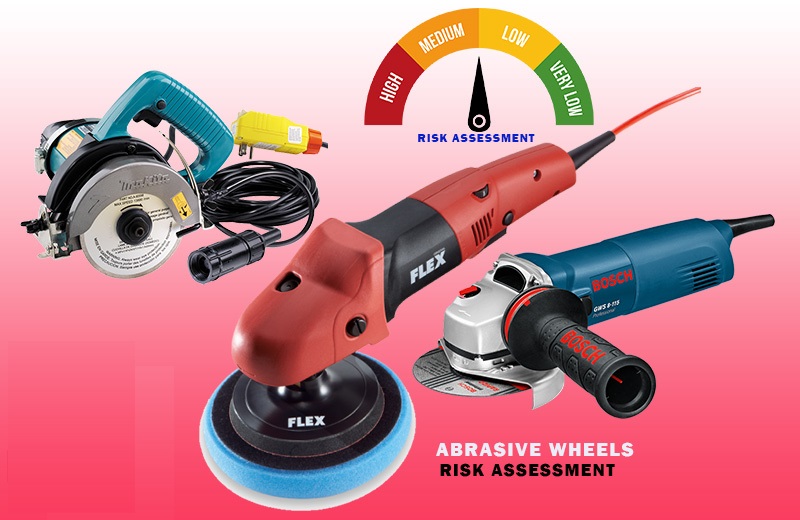This risk assessment is applicable for Chop Saws, Angle Grinders, Bench Grinders, cutting and grinding tasks in mechanical, fabrication and electrical disciplines.
Hazards related to abrasive wheel include:
- Fire/explosion through ignition of sparks
- Bursting of abrasive wheel or disc at high speed
- Contact with wheel or disc resulting in laceration or amputation
- Losing control of the Equipment
- Clothing entanglement with moving parts
- Personnel injury‐ Eye injuries/blindness from flying parts
- Injury to bystanders
- Inhalation of dust/fumes
- Exposure to excessive noise levels
Control Measures while using Abrasive Wheels
Operate all tools as per manufacturer’s instructions.
Only trained and competent personnel should change discs.
Ensure there are trained and competent personnel on site to do this work. Only those trained in conjunction with the Abrasive Wheel Regulations 2016 as allowed changing a disc.
PPE is provided and its use is mandatory especially full visors (full face visor) Safety Glasses under the face shield/visor.
Agree Hot Works Area with client before any Hot Works commences, and hot work permit system must be in place before starting work.
Fire prevention equipment must also be in place i.e. Fire blankets, fire extinguishers etc.
Area around grinding should be cleared from all combustible materials.
The area should be adequately screened and signs posted to inform and protect other trades/ visitors of flying particles.
Always unplug the grinder before altering guards or changing discs.
Use the correct disc for the job, cutting discs for cutting and grinding discs for grinding.
Power rating, spindle speeds and identification number to be clearly identified on all grinders including bench mounted grinders.
A visual inspection is required by the operator before use of all machines and discs for damage.
Ensure all switches and safety devices are operating correctly before using. “Dead Man” switch fitted (angle grinders).
Guards always correctly positioned, properly adjusted and cleaned before use.
Always secure working item in a vice or clamp.
Always stand on firm level ground while grinding.
Ensure that bench mounted grinders are dressed on a regular basis (levelled out).
Loose clothing, long hair should be rolled/tied up, jewelry should also be removed.
Appropriate PPE must be worn and should be in good condition. Full face shield, ear defenders and breathing apparatus if necessary to be used.
110 volt equipment only to be used with easily accessible on/off switch.
Provide adequate ventilation working in a confined space and control the cutting activities.
Ensure abrasive wheels are stored correctly in dry containers, in manufacturers packaging.
Abrasive wheels should be checked before every use and on a monthly basis.
Any defects to abrasive wheels should be reported to a supervisor immediately.
Do not cut overhead if possible.
When cutting concrete/tarmac/pavement slabs, use water to safeguard against dust, where possible.
Do not adjust a grinder when it is running.
Blotter and wheel flanges used to mount the grinding wheels on the shaft of the grinder, must be in place.
Tool rests must be adjusted and tightened to ensure that there is less than 1/8 inch gap from the wheel.
Wheels should be inspected prior to turning on the power.
Wheel with cracks or chips, or that are badly rutted, should not be used.
They may require dressing or permanent removal from service.
Do not grind on the side of the abrasive wheel.
Check that the speed rating of the grinding wheel is equal or exceeds the speed rating of the grinder.
The maximum approved speed stamped on the wheel blotter should be checked against the arbour speed of the machine to ensure that the safe peripheral speed is not exceeded.
Preventive Measures during the Operation
Before commencing grinding, allow the grinding wheel to run at operating speed for at least one minute.
When commencing a grinding operation, bring object into contact with the grinding wheel slowly and smoothly, avoid impact or bumping motions.
Move the object being ground, back and forth across the face of the wheel, as this prevents ruts or grooves from forming.
Dress the wheel on the face only.
Dressing the sides may cause it to become too thin for safe use.
Use the face of the wheel when grinding.
Do not press too hard on the wheel.
Vibrating wheels should not be used.
They must be dressed, and replaced if the bearings of the shaft are worn.
Do not touch the ground portion of the work piece until you are sure it is cool.
Shut off the power and do not leave until the wheel has come to a complete stop.
Clean the work area when finished using the grinder.
Disconnect angle grinders from the power source when making repairs or changing discs.
Discover more from Project Management 123
Subscribe to get the latest posts sent to your email.